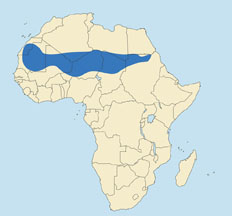 |
Oryx dammah
Orix cimitaria (Sp), Säbelantilope (G), Oryx algazelle (F). The name "white oryx" is sometimes misapplied to this animal; the true white oryx is the Arabian oryx (Oryx leucoryx) of the Middle East.
DESCRIPTION Shoulder height 43-49 inches (110-125 cm). Weight 295-310 pounds (135-140 kg).
A beautiful animal with very long, scimitar-shaped horns. A large, heavily built antelope, very pale in color except for its reddish brown neck and chest. The face is white with brownish markings. The tail is long and tufted. The hoofs are large for walking on the sandy soil of its habitat. Both sexes grow horns, which are ringed and nearly parallel. Females are similar to males, but have slimmer horns.
BEHAVIOR Gregarious, usually found in herds of 10-40, sometimes more. Seldom solitary. At times old bulls would join herds of dama gazelles. At certain times of year, after rains had fallen, they formerly gathered in enormous herds of 1,000 or more. Very nomadic, traveling long distances in search of grazing. Migrations were east and west, contrasting with those of addax which are north and south. Fed mainly on grasses, legumes, succulent plants, acacia pods and fruits. Able to get by with very little water, subsisting on moisture from its food. Life expectancy more than 18 years.
HABITAT Semi-desert, seldom entering the desert proper.
DISTRIBUTION Originally ranged over 1,500,000 square miles (4 million square kilometers) from Morocco to Egypt and from Mauritania to Sudan along the edges of the Sahara Desert. Now extinct in the wild because of uncontrolled hunting by soldiers, tribesmen and oil explorers, and from competition with domestic livestock for the limited vegetation available.
Kept as a domestic animal by the ancient Egyptians, and many private herds exist today in various parts of the world, especially in South Africa and Texas. According to the IUCN, as of 1996 there were at least 1,250 individuals in zoos and parks around the world and several thousand on Texas ranches.
STATUS Listed as extinct in the wild by the IUCN (1998) and on Appendix I of CITES (1975).
|




